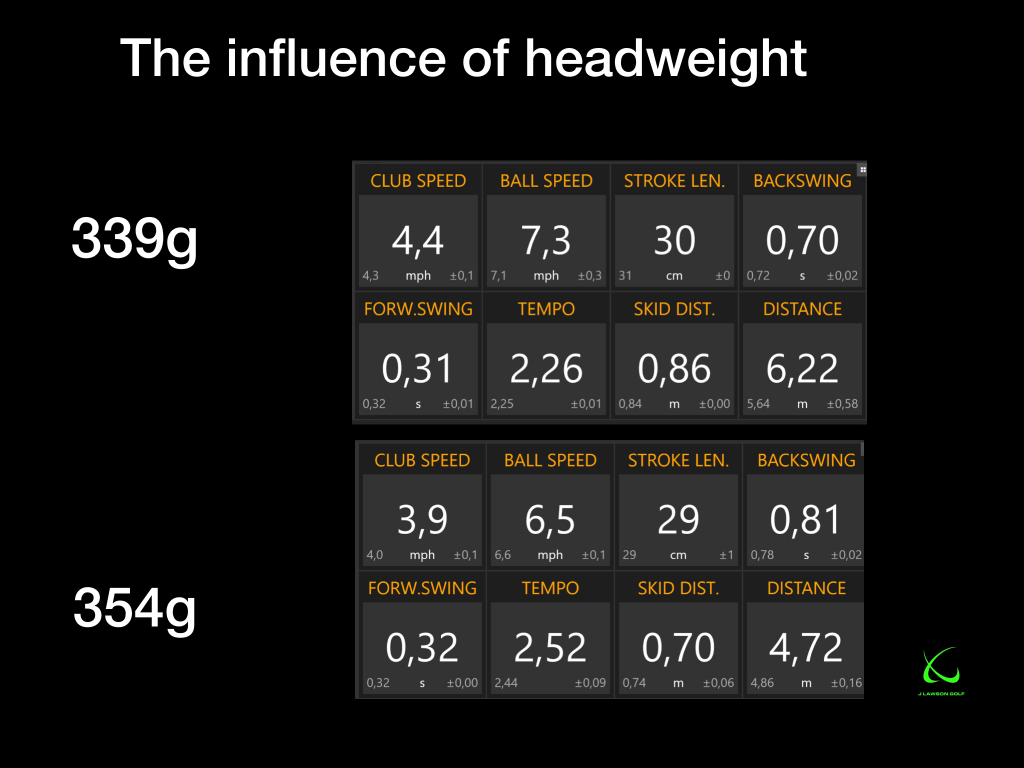When most golfers think about custom fitting, they think about drivers. The experience can be magical. A player and a trained fitter tinker with different head and shaft combinations, tweak lofts and adjust moveable weights. Presto, the ideal combination adds 15 yards of distance off tee and the golfer is hitting straighter shots.
Putters, on the other hand, rarely come to mind. That’s a huge mistake. Elite golfers will use their driver, typically, fewer than 10 times in a round but roll 27 to 30 putts. Weekend players may reach for their driver more often than pros, but they putt more too, often up to 35-40 times per round. A custom fit putter that augments your natural stroke can enhance your chances of performing better on the greens and lower your scores.
Putter Swing Weight Increase Size; Tiger Woods Putter Swing Weight; The Best Golf Putter. See More Reviews. See More Reviews. The first golf putter included in our collection is the Pinemeadow Golf PGX. We all search for that one putter, ergonomically crafted for the perfect fit, to make putting more enjoyable and less arduous. In simple terms the moment of inertia is the measure of a putter's resistance to twisting on off-centre hits. The greater the moment of inertia, the less the putter blade rotation and loss of energy. The way to increase the MOI of a putter is to move weight away from the centre of gravity (CG).
If you recently read my story on Arccos Caddie Strokes Gained Analytics, you know I’m an average player. My handicap is 13, and while I would love more distance and accuracy off the tee and need to sharpen my iron game, I’m a decent putter. But when Club Champion asked if I would like a putter fitting, I jumped at the chance. Here’s what I learned.


Safety first
I had not taken three steps inside Club Champion’s Hartford, Connecticut, faculty before Mitchell Becker, a PGA of America professional and my fitter for the morning, asked me to use some hand sanitizer. He also used some while we talked, and like me, he wore a mask. Becker explained that every morning before the store opened, it was thoroughly cleaned. Aside from fist-bumping instead of shaking hands, everything about the fitting experience felt the same as fittings before the COVID-19 pandemic. I felt very safe.
Know thy stroke
Before we did anything, Becker measured my putter and learned it is 34 inches in length and has 3 degrees of loft. That would be our starting point.

Launch monitors like TrackMan and Foresight do a great job revealing things like the launch angle, spin rate and ball speed you create with a driver off the tee. On the green, technology can show you data points and tiny details about how you aim, your stroke’s path and what is happening at impact.

Science & Motion’s SAM PuttLab is the device of choice at Club Champion. After attaching a small plate to your putter’s shaft, the Y-shaped machine uses ultrasound to track the club as it moves. Calibrating it using my putter took about 15 seconds, and putting from a predetermined spot on the artificial green, it collected information as I made seven 10-foot putts. Becker quietly studied my posture and alignment while standing about 10 feet behind me. The SAM PuttLab analyzed everything else.
It turns out my aim is good. On average, my putter’s face was pointing only 0.5 degrees to the hole’s right at address. Becker said he had seen golfers who aim as much as 10 degrees away from the cup.
Coming into impact, my putter does not swing straight through the ball. Instead, it rises an average 1.7 degrees.
Many people do not realize that the ball’s weight creates a tiny depression in the green and that a putter’s loft is designed to get the ball out of that depression. Too much loft can make the ball hop, but too little loft will drive it into the ground.I have a slight forward press, so while my putter has 3 degrees of loft, the playing loft at impact usually is 2.1 degrees. Luckily, my combination of effective loft and rising swing was good.
SAM also revealed I have a moderately arced stroke. The head swings to the inside of my target line on the takeaway and on the follow-through. As I make my backswing, it also showed the face opens an average of 7.4 degrees, and it closes an average of 15.7 degrees on the follow-through. In other words, it’s rotating, but at the most critical moment – impact – it was open 0.6 degrees to the right. Again, that’s pretty good. That combination of arc and rotation indicated that a face-balanced putter would be wrong for me, but that either a blade or mallet-style putter with 30 to 45 degrees of toe hang could be an option.
Putter Swing Weight Increase Chart
Length and lie angle are critical
While I holed six of the seven putts the SAM device studied, it showed I made contact slightly toward the toe of the face on all but one putt and that the toe of my putter was elevated by about 2 degrees. In the ideal setup, the putter should be flat.
At impact, the lie angle was 68 degrees. By flattening the lie angle to 67 degrees and adding an inch in length to the club, the impact spot could be shifted more to the center of the face for improved consistency.
Becker bent the lie angle of the putter I was using 1 degree flatter, but I could not see any difference at address. Then he handed me a putter with the same specs but that was one inch longer. I felt the difference immediately. It was only an inch, but I felt more upright and more comfortable. However, because the lie angle was ideal, my eye position over the ball was in the same location, so my aim was not affected.
In 20 minutes I had learned that I need a putter with 30-45 degrees of toe hang, 3 degrees of loft, a length of 35 inches and a lie angle of 67 degrees. After that, everything is my preference.
Grips, alignment aids and customization
Once you know what you need, a good custom fitter can help you sort through the scores of putters on the market that are viable options.
Putter Head Weight
A mallet or a blade?Large grip or small?Chrome, black, white, blue?Alignment lines, alignment dots or both?Custom stamping?So, what putter did I get? In the end, I opted to keep the same heel-toe-weighted blade that I walked in with, but with a few modifications.

The putter was given a longer shaft, a small amount of extra weight was added to the tip section to increase the swing weight and I switched to a new midsized grip.
I walked into my putter fitting with a club that pretty closely matched my stroke and walked out with an even better one.